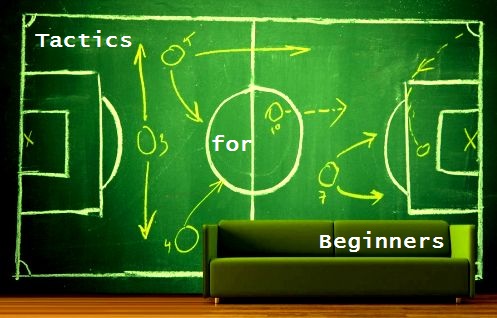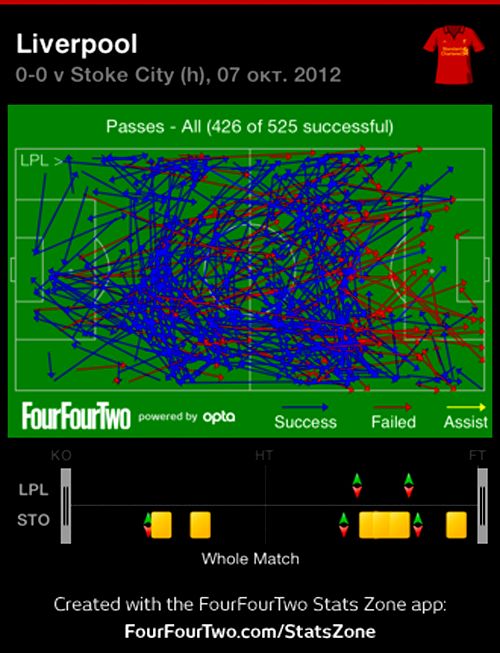By Bob Pearce and Mihail Vladimirov.
Through, over or around?
The more we talk the more I have become interested in what seems like a key patch of grass. It is the strip between the edge of the box and the start of the final third. In terms of lines of play it is the patch between the deep sitting back line and the midfield and will include the ‘hole’. We’ve talked about how everything that happens everywhere on the pitch has importance, but this seems to be a key place, where attacking teams seek penetration, and defending teams seek preservation. The penetration/preservation zone.
Last time you showed that chalkboard of Stoke defending their final third to demonstrate how they successfully controlled that space. They seemed to be successfully nullifying and frustrating attacks by actively reducing the options available down to those options that suited them – long shots and crosses from deep.
So their focus was less on the ball and more where the ball can go next?
There are two considerations worth mentioning here. First, from a purely tactical point of view every team that prefers to defend with deep and compact lines is obviously going to leave space out wide. But given their compactness they are happy to do so, as they would have the bodies to deal with any incoming crosses.
Then speaking precisely about Stoke, as we all know, they are a team that would love to push the opponents out wide and force them to just cross the ball. The team is perfectly equipped to deal with such a threat. Given the nature of their players it’s logical they are happy to face that kind of threat.
So there is not always need to tackle or engage the attacking player. Often what is required is to be blocking off a passing angle or presenting a path of less resistance for the attack to take, which is less dangerous for the defending team.
Yes, this is the so called ‘blocking off’ process. Basically the defending player is showing the attacking player either a zone or a direction that is less favourable not only for the attacking player individually but for his team as a whole.
Let’s take for example an inverted winger. There is no need for the full back to engage him at all. It could be as simple as the full back blocking the path of the inverted winger infield and showing him on the outside. By doing this the effectiveness of the inverted winger would be dramatically reduced, as he would be forced to play on his ‘weaker’ foot, and in a zone where theoretically his team’s patterns of play are not wanting him to go.
He is not able to fulfil his role to come inside and join the attack, he is then not leaving space for his full back to move into, and the planned patterns of play can not be developed to deliver goal scoring opportunities. So this apparently simple measure is actually nullifying multiple threats at once.
Precisely. That’s why in this case the attacking team would do better to have one of the midfielders going wider to be able to create a passing triangle in order to help out his wide partners.
In a ‘two banks of four’ reactive team, how do the midfield four operate differently from the back line four?
In terms of defensive behaviour and positioning it’s not so different. Both lines would have the same main aim – to compress the space for the opposition. Both lines would do the same thing – drop deep and try to be as compact as possible. Hodgson’s teams are the perfect example of this behaviour. The way he drills his teams to defend with two banks of four is exceptional. They are both acting in the same way and are moving ‘as one’ – everything is so perfectly synchronised.
When a proactive Red team is up against a reactive Blue team that sits back and ‘freezes’ the ‘hot zone’ into a ‘wall of ice’, as far as I can see they have three options. They can try to go through, over or around. Because Blue team are defending deep there is very little space to go ‘over’ into. Because they are defending in a tight cohesive way there is little or no space to go ‘through’. Because they are defending narrow the most likely route is for Red team to go ‘around’. If you are facing two banks of four is the most likely route to success trying to create space by trying to stretch them horizontally by playing with as much width as possible?
Yes. That’s why when you face a deep, compact and narrow opponent happy to just sit back and soak up the pressure, you need lots of stretching capability in order to try to force them to move around and open up pockets of space somewhere within their compact unit. But the width shouldn’t lead simply to providing hopeless crosses into the crowded area for your big man to try and challenge for. That’s where the passing and movement patterns are so crucial. Once you have managed to force them to go wider (as a result of your stretching), the next phase is to offer that diversity, fluidity and cohesion in terms of passing and movement. The traditional way to do so is to have overlapping full backs, incutting wingers and either a midfielder or a forward drifting wide to create triangles and carry the ball infield using short and sharp passes within those triangles. Then once in or around the penalty box, those triangles should incorporate an additional midfielder or forward (in place of the full back who should stay out wide to keep the width and force the opposition to stay wide with him) to continue having triangles but with the aim of working good shooting angles using more penetrative passes within those triangles. All of this becomes much easier to execute if you have players with the ability to pass, move and dribble past opponents.
Whether you play a high or deep defensive line you will need to stay ‘in touch’ with your midfield or you will be isolated and exposed. What can attacking teams do to stretch the space vertically between the midfield and defence to expose the defence?
Depends. If the defending team is staying deep the attacking team could use the approach we discussed above with width and triangles.But if the defending team is using a high defensive line the attacking team could simply chose to focus on the space in behind. In this scenario there is no point for the attacking team to try and target the space between the lines, given the theoretical free space left in behind. So a simple ball down the channels or over the top could do the job of providing that vertical effect. Additionally you could have your team stretching them vertically too.
Once the horizontal stretching is under way you could have your deep-lying midfielders and even one of the defenders push forward and try to overload the opposition vertically. The aim is simple – use the width to stretch them, and then use the verticality to simultaneously overload them.
In theory the 4-2-3-1 formation is the most suitable when it comes to both creating the required triangles on the outside to provide the width, then use runners from deep to overload the opposition vertically. The player in the hole is available to join either flank in order to create the triangles with the full back and the winger. Then one of the double pivot and one of the centre-backs could push forward to provide the additional midfield runners.
The 4-1-2-3 shape is naturally more adept to create those triangles as the shape has two midfielders (i.e. the ‘2’) who could simultaneously drift wider to create triangles on both flanks in the same time. But the shape is not so adept to provide additional midfield runners as the centre-backs and the deepest-midfielder are needed to stay at the back. So only one of them could be available to push up vertically.
The rest of this post is for subscribers only.
[ttt-subscribe-article]

